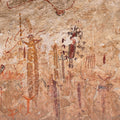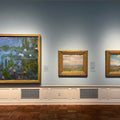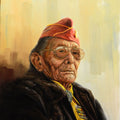Speed Art Museum in Louisville Presents Some of the Earliest Photos of the American West
By Chadd Scott on
They are among the earliest photographs of the West. Timothy O’Sullivan’s pictures of what would become Arizona, Colorado, Nevada, New Mexico and Utah. Famous places: the Grand Canyon, Zuni Pueblo, Shoshone Falls, ID, Snake River, ID, Canyon de Chelly.
O’Sullivan (born in Ireland, about 1840–1882) was part of an 1871 government-sponsored expedition lead by Lieutenant George Wheeler surveying and documenting the territories west of the 100th meridian, a longitudinal line running straight down the Great Plains from present day North Dakota to Texas. In his photographs, O’Sullivan created carefully constructed images conveying the ruggedness, vast scale, and the natural grandeur of the American West.
He pictured Native people, Indigenous ruins, waterfalls, gorges, mountains, saguaro cactus, rock formations – the same topics fascinating artists and photographers today. Picture makers who continue to borrow from O’Sullivan. Ansel Adams hailed him as one of the most important photographers of the nineteenth century and a precursor to Modernist photographers.
As the first photographer to venture into many of these places, the first to record some of the West’s most iconic landscapes, O’Sullivan established a new visual vocabulary for landscape photography.
Twenty-five of Sullivan’s extraordinary pictures from his landmark series “U.S. Geographical Survey West of the 100th Meridian” are on view now through August 25, 2024, at the Speed Art Museum in Louisville. The museum’s portfolio is being shown in its entirety for the first time since undergoing recent conservation.

“As I started looking at these, the one that I'm drawn to, and I think a lot of people are drawn to it –certainly Ansel Adams was – was the ancient ruins in the Canyon de Chelly and this striking image of the cliff dwellings of the ancient Puebloan and people,” exhibition curator at the Speed Art Museum Kim Spence said. “I love the way he fills the picture frame. In many ways, he was creating a new visual vocabulary. He was being very conscious in the choices he was making as a photographer of where to set up his camera. Very aware in his selection of a view and you see this especially in the images of Shoshone Falls.”
O’Sullivan had been there before.
In 1867, he joined Clarence King's geological survey of the fortieth parallel, a line forming the Kansas-Nebraska border running through Boulder, CO and beyond. That marked the first federal expedition in the West after the Civil War, a catastrophe O’Sullivan also photographed.
O’Sullivan produced about 10 different compositions from Shoshone Falls, four of them represented in the Speed’s portfolio of images.
“You see him making very conscious and subtle decisions in terms of where he placed his camera, framed it, and the context. In some of these he would include a very, very small figure, a single lone figure standing on the edge of the falls or the edge of the riverbank to help give scale,” Spence explained. “Another one, he's kind of behind the falls and you get a sense of this mist being sprayed up even though you don't see the falls themselves. That image reminds me that people who visited the falls in the 19th century said you could hear the sound – this thunder of the falls – from as far away as 10 miles. From his point of view, (he’s thinking) how do you visually capture that impact?”
O’Sullivan didn’t produce any traditional, posed portraiture on the surveys, although there are images of indigenous people and fellow expedition members he photographed within the landscape.

Capturing the West
While admiring the images, never lose sight of the conditions they were produced under. The heat, the cold, the rain, the terrain. Sleeping on the ground. Lugging heavy equipment.
The photographs are albumen prints – all sized 20x16 or 16x20 inches – created using the wet collodion process. That requires a large format box camera, roughly 9x12 inches square standing on a huge tripod.
“It's a huge piece of equipment, but compounding the bulk of it is the fact that he had to prepare the glass plates, take the photograph, and then process them in the field, all within a period of five minutes because the wet collodion process requires a wet emulsion that is applied to the glass plate – you had to process it and fix the image on the plate before that dried,” Spence explained. “One of my favorite images in the group is a photograph called Black Canyon Colorado River Looking up from Camp Seven. There's a flat bottom boat that's anchored at the edge of the river; that was a boat that (O’Sullivan) led on the expedition. He was the captain of that boat he nicknamed The Picture, and it also served as his darkroom. He would set up a little tent and crawl underneath and it was in there that he would process the plates and develop his images.”
Through all of this – bumping around on horseback, traversing rapids – he had to take care in not breaking the large glass negatives. Those needed to be transported all the way back to Washington. where the images were printed as photographs. They didn’t all make it. Many were destroyed in transport.
As the story goes, when traveling through Death Valley, the heat was so intense it caused his photographic chemicals to boil.
From the surviving plates, thousands of prints were distributed. The Speed’s photographs came as a 1995 gift from the Louisville Public Library when deaccessioning its art collection. Spence can’t be sure, but her working theory is that the library acquired the pictures from a precursor known as the Louisville Polytechnic Society.
“During the late 19th century, after O'Sullivan had traveled out west and albums of these photographs were being distributed, they were going to universities, they were being distributed to members of Congress, but there was (also) a clear intent to use these for educational purposes associated with geography departments so I could easily see these have coming into the collection of the Polytechnic in that context during the late 19th century,” she said.
In addition to the big box camera, Sullivan also took a smaller stereograph camera with him. He was simultaneously making a second set of images in a format more popular for public consumption via stereograph viewers – personal use, 3-D, View-Masters of the day. Through this platform, the American people “back East” were becoming increasingly aware of the geography and nature of the Western landscape.

Timothy H. O'Sullivan, American, born Ireland, about 1840-1882, ‘Cañon de Chelle,’ 1873. Albumen print, 16 x 20 in. Gift of the Louisville Free Public Library.
Seen and Unseen
The Speed’s exhibition does more than share beautiful, early photographs of the American West and reveal O’Sullivan’s avant-garde photography techniques.
“When you think of Timothy O'Sullivan, you often think of him hand-in-hand with Ansel Adams, and Ansel Adams’ reinterpretation of (O’Sullivan’s) Canyon de Chelly image in the 1940s, but something that I don't think has been acknowledged enough, is that when Timothy O'Sullivan and Wheeler and the survey crew were exploring the West, they were photo-documenting it as if they were virgin territories, but these were all lands that had been populated for centuries by indigenous peoples,” Spence explains.

Timothy H. O'Sullivan, ‘Section of South Side of Zuni, Pueblo, N. M.,’ 1873. Albumen print, 16 x 20 in. Gift of the Louisville Free Public Library.
Western painters of the same era – Albert Bierstadt and Thomas Moran – played the same trick, portraying the West as unpeopled, up for grabs.
“Object labels and the introductory text panel itself, we address that this survey project, while it has scientific goals, it was all part of this United States policy of westward expansion, and that tribes were actively being displaced as settlers were moving west,” Spence said. “Underlying all of this too was an understanding that the survey would help identify resources – gold, silver – whatever natural resources settlers or corporations could discover or take advantage of as they migrated west.”
Suddenly, the pictures aren’t so pretty.
At the same time O’Sullivan was taking photographs of the West, America was just taking it. Art in the service of America’s colonial ambitions. Ambitions resulting in a genocide. Many of them. Realities not be forgotten when admiring his pictures.



